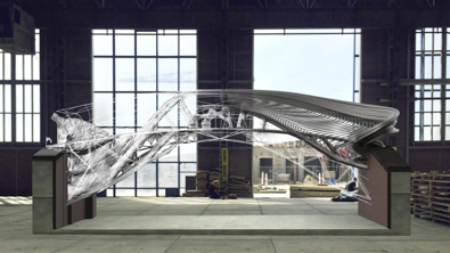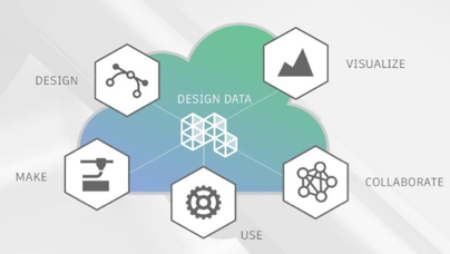Key takeaways:
- Autodesk is establishing itself as a pioneer in cloud services by aggressively deploying a web services platform, building new cloud-based applications, creating new business models, and establishing a modern developer network
- Autodesk is driving to host a “Common Data Environment” for customers across its industry verticals, and to establish a growing portfolio of branded web services, third-party solutions, and independent integrations which use this data
- Artificial intelligence (machine learning) was prominent, with examples ranging from product design optimization to construction risk reduction, and customer service improvement for Autodesk subscribers
- The challenge for Autodesk will be to successfully bridge to the future for the millions of customers using its established applications, while simultaneously winning out over its competition as it expands into new disciplines and markets
The mythological Roman deity Janus had two faces—one looking to the past and the other to the future. Janus is a fitting metaphor for Autodesk at its annual Autodesk University (AU) customer event in Las Vegas. Autodesk has grown over the past 34 years by serving a diverse range of customers with tools for product design, manufacturing, architecture, engineering, construction, digital entertainment, and more. While Autodesk receives much of the attention, its success has both fostered and depended upon an extensive ecosystem of third-party developers that have extended its products to meet the needs of customers. Autodesk is rapidly pivoting to the future, introducing new cloud applications at an accelerating rate, while expanding the web services platform on which those applications are built. The company is also inviting developers to participate in this transformation through Forge, an innovative platform based upon open application programming interfaces (APIs) that enables customers and third parties alike to participate in the Autodesk ecosystem.
Keynote Presentations and Analyst Sessions
CTO Jeff Kowalski spoke about the duality of technological progress in the past—innovations have enabled new possibilities, but have also imposed constraints driven by implementing those technologies. Some of the latest technologies hold promise to break those constraints. Mr. Kowalski envisioned a future in which tools no longer constrain expression, but create the potential for unlimited expression. In this future, which Autodesk promises to deliver on very soon, the design, fabrication, and ongoing experience of products and buildings will be the result of close collaboration among people and machines. Artificial intelligence (AI, also referred to as machine learning) is the keystone technology for this future, enabling humans to focus on outcomes and constraints, while machines explore potential solution spaces and present their human masters with optimal alternatives. Autodesk is using AI in Project Dreamcatcher, a generative design solution that will be commercially available in 2017. The company used AI and generative design to develop the layout for its new Toronto office, using optimization criteria such as team interactions and exposure to natural light. Continuing the design theme, Mr. Kowalski explained how Autodesk is using Virtual Reality (VR) to provide a richer, more immersive design and collaboration experience. He showed how Autodesk is connecting design and fabrication for a bridge that was designed using generative solutions, and is being constructed in Amsterdam using robotics combined with additive manufacturing.

Figure 1—Generatively Designed Bridge in Partnership with MX3D for Robotic Fabrication
(Courtesy of Autodesk)
CEO Carl Bass continued the theme, stating that it is essential for companies to experiment with new technologies, and to run toward disruption rather than shy away from it. In Mr. Bass’ words, “disruption can be the source of true value,” and companies who fail to embrace disruption will be outpaced by those who do. He also expressed his opinion that the next generation of professionals is much more open to experimentation and innovation. Mr. Bass invited Ms. Anna Nixon, a 16-year-old high school junior, to the stage to prove that point. Ms. Nixon has been participating in FIRST Robotics since second grade, and has used technologies such as computer vision and machine learning combined with fabrication techniques as part of award-winning robotics teams. In her very impressive presentation, she expressed how important collaboration is—everything she has done in FIRST Robotics has been part of a team.
Later that afternoon, Autodesk held an analyst and media briefing that began with a panel exploring the societal implications of this disruption, such as future employment prospects for truck drivers in an era of autonomous vehicles. It is clear that no one knows the answers to the challenges. Mr. Bass and Mr. Kowalski then took questions from the audience. Mr. Kowalski expressed that Autodesk is committed to open innovation, even if new solutions come from companies other than Autodesk. Mr. Bass acknowledged that Autodesk will need to work to bring customers into the future, and in some industries such as construction this will involve updating traditional risk-averse business practices. He also expressed that Autodesk wants to enable customers to create a complete definition of a product, and to be able to “turn on” that product virtually.
The keynote presentation on the second day of AU began with Senior VP of Products Amar Hanspal, who covered continuing improvements to current products as well as the investment into new cloud offerings. Mr. Hanspal promised that Autodesk will continue to fulfill customer needs for existing products to deliver value to subscribers—an important point now that Autodesk has transitioned to a business model based upon term subscriptions for all new sales. He reinforced Autodesk’s strategy to provide a common data environment at the center of a collection of applications and web services, supported by the Autodesk Forge platform. Mr. Stephen Hooper, Senior Director for the Fusion product line, revealed the progress Autodesk has made with Fusion 360 with the integration of Fusion Lifecycle and Fusion Connect. He unveiled several new capabilities that are either available now or will be soon—notably including a zero-client version of Fusion 360 that will run in any compatible browser. This capability is clearly targeted at eliminating a differentiator for the competitor Onshape.

Figure 2—Common Data Environment at Center of Cloud Applications and Web Services
(Courtesy of Autodesk)
Mr. Don Parker, Senior Director for Shotgun, discussed major new capabilities in the Shotgun product for managing creative workflows for film and games. Autodesk is expanding the coverage of Shotgun to include multi-site and multi-company collaboration with role-based interactions for creative artists, managers, and editors alike. Ms. Sarah Hodges, Director of the BIM 360 business line, discussed progress over the past year since BIM 360 Docs was revealed at AU 2015. More than 100 of the largest global contractors are now using BIM 360, and she invited the CEO of one of those companies, Mr. J.E. Dunn, to discuss how his company built a sophisticated internal application (Lens) that includes an ERP integration using the BIM 360 API on the Forge platform. She also unveiled Project IQ, which leverages AI and historical construction data to proactively reduce risk for construction projects. The session concluded with Mr. Hanspal revealing Project Quantum, an initiative inside Autodesk to deliver architectural design, engineering, structural analysis, fabrication, and construction as part of BIM 360. In effect, this will provide Revit and more functionality on the cloud. Autodesk is leveraging a common platform for its new cloud applications, and extending access to these through the Forge platform and its open APIs.
Later that afternoon, another analyst and media briefing was led by Mr. Andrew Anagnost, Senior VP for Business Strategy and Marketing. Mr. Anagnost discussed new partnerships and how many of Autodesk’s innovations are being used by customers, and revealed some interesting numbers on Forge adoption. At the time of his presentation, more than 7,000 developers had created Forge accounts and had created more than 4,000 applications (this may represent apps under development in addition to completed apps). More than 1,000 developers attended the first Forge DevCon in June 2016, and more are expected at the next DevCon event in 2017.
A panel consisting of Mr. Amar Hanspal, Mr. Don Parker, Ms. Sarah Hodges, and Mr. Stephen Hooper took questions from the audience. One question dealt with how Autodesk will fulfill customer expectations to capture all aspects of product definition, especially given the growing importance of controls and software. Mr. Hooper explained that the Fusion 360 platform is more than just a collection of features, and gave the example of the rapid integration of the EAGLE ECAD acquisition to provide PCB design and simulation within Fusion. Mr. Hooper said that we should expect to see greater integration of electronics, controls, and software within Fusion. He also emphasized the role of Fusion Connect to address sensors for both development and predictive maintenance. Another question focused on Project Quantum and whether it will be “Revit on the cloud”. Mr. Hanspal answered that Revit functionality will be part of Quantum, and that customers will expect compatibility, but that Quantum will be more than just what Revit is today. He emphasized the importance of looking at BIM 360 as a platform, enabling new integrated capabilities such as quantity takeoff and estimating. A question about the Forge platform delved into openness—will Autodesk be open to competitive integrations? Mr. Hanspal answered that the extensibility of the Forge platform is important to its success, and that Autodesk is working closely with enterprise customers, system integrators, and third parties to build applications. He said that Autodesk will be open to “about 95%” of applications, but will take exception in cases where a competitive product closely duplicates functionality of an Autodesk offering. Expanding Forge, including the addition of new and nontraditional partners, will be a key part of Autodesk’s strategy.
CIMdata Perspective
Autodesk deserves credit for its success so far in managing a blizzard of transformations. In addition to its highly visible cloud platform initiative, the company has been the most aggressive among its peers in the PLM market in moving toward a term subscription business model. It has established several initiatives to promote more direct interaction with customers, while continuing to support its extensive reseller channel. Challenges remain, notably driving longer-term adoption of new solutions by its millions of existing customers, successfully entering new markets (some with established competition) as it expands its offerings, and minimizing subscriber churn. Still, considering its performance to date, the company deserves recognition for delivering on its aggressive plans.
To fulfill its ambitions and the needs of future customers, Autodesk will need to build out its solutions or establish partnerships in areas such as systems modeling and simulation, controls and software integration, and deeper construction and facilities management capabilities. Although in the short term the Forge platform requires considerable investment, in the medium term it could help Autodesk deliver these additional capabilities much more rapidly. Forge applications can also be a powerful tool to help existing customers transition to Autodesk’s modern platform. One key factor will be Autodesk’s commitment to openness with Forge. Comments by Autodesk are encouraging in this regard, as is Autodesk’s history with the Autodesk Developer Network, which has been a positive model of openness and flexibility in the industry for many, many years. Autodesk will also need to continue transforming its go-to-market processes and footprint to support growth with new customers and in select new markets.
In summary, CIMdata considers Autodesk University 2016 a very successful event. The company once again attracted a large audience—more than 10,000 people—and demonstrated to them that it is delivering on its promises. It continues to raise the bar with an expansive vision built upon a modern technology foundation, while continuing to advance the existing desktop applications that provide the bulk of its revenue today. While Autodesk continues to learn from its past success and support its current customers, it is increasingly delivering on a future which represents a radical transformation from the company it was only a few years ago.




